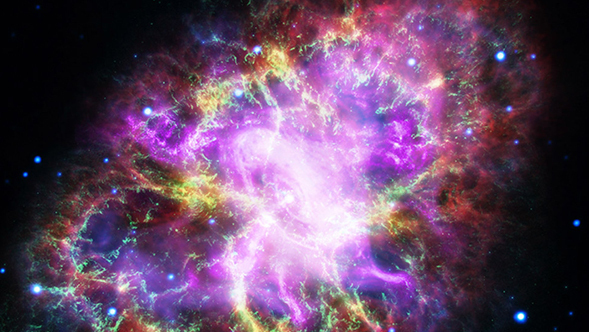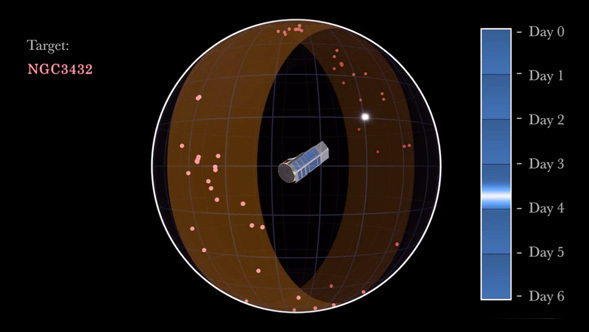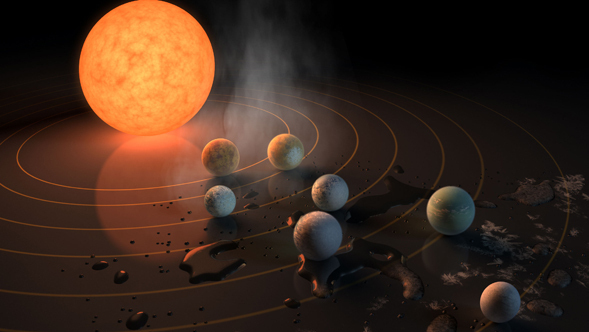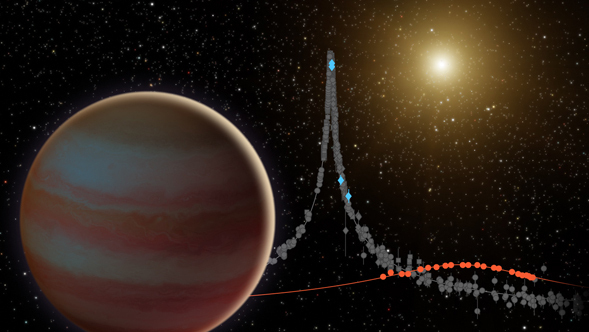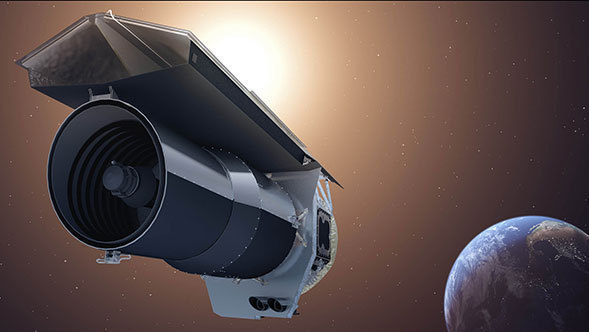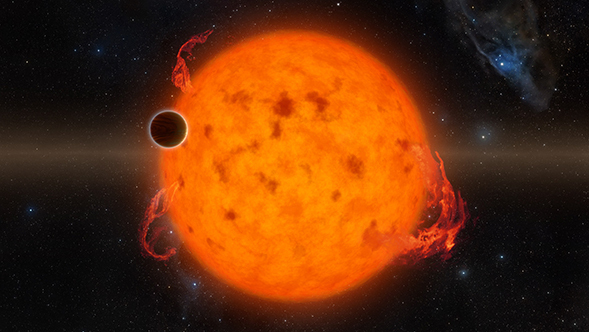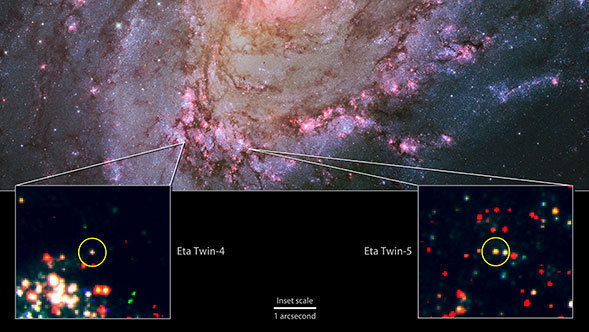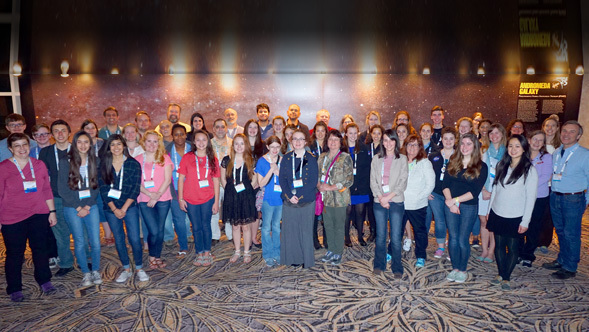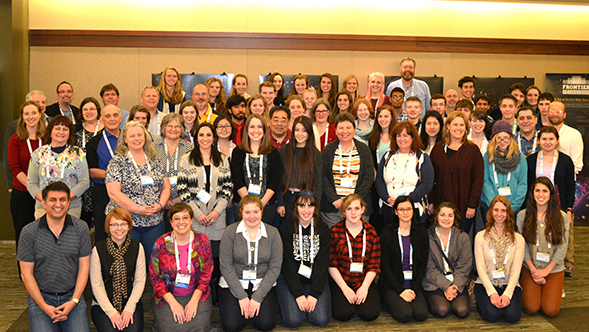Displaying news 91 - 120 of 587 in total
Astronomers have produced a highly detailed image of the Crab Nebula, by combining data from telescopes spanning nearly the entire breadth of the electromagnetic spectrum.
May 3rd, 2017 marks the 5,000th day of NASA's Spitzer Space Telescope mission. This video gives us a detailed look at six of these days, showing how an automated observatory like Spitzer, which is effectively an astronomy robot, spends its time. It’s overall mission design allows for an unprecedented degree of efficiency, allowing it to study the full range of astronomical phenomena including nearby objects in the solar system, stars in our galaxy, and galaxies out to the edge of the observable universe.
Scientists have discovered a new planet with the mass of Earth, orbiting its star at the same distance that we orbit our sun. The planet is likely far too cold to be habitable for life as we know it, however, because its star is so faint. But the discovery adds to scientists' understanding of the types of planetary systems that exist beyond our own.
Astronomers have detected a huge mass of glowing stardust in a galaxy seen when the universe was only 4 percent of its present age. This galaxy was observed shortly after its formation and is the most distant galaxy in which dust has been detected. This observation is also the most distant detection of oxygen in the universe.
NASA's Spitzer Space Telescope has revealed the first known system of seven Earth-size planets around a single star. Three of these planets are firmly located in the habitable zone, the area around the parent star where a rocky planet is most likely to have liquid water.
A planet and a star are having a tumultuous romance that can be detected from 370 light-years away. NASA's Spitzer Space Telescope has detected unusual pulsations in the outer shell of a star called HAT-P-2. Scientists' best guess is that a closely orbiting planet, called HAT-P-2b, causes these vibrations each time it gets close to the star in its orbit.
In a first-of-its-kind collaboration, NASA's Spitzer and Swift space telescopes joined forces to observe a microlensing event, when a distant star brightens due to the gravitational field of at least one foreground cosmic object.
In the ongoing hunt for the universe's earliest galaxies, NASA's Spitzer Space Telescope has wrapped up its observations for the Frontier Fields project. This ambitious project has combined the power of all three of NASA's Great Observatories -- Spitzer, the Hubble Space Telescope and the Chandra X-ray Observatory -- to delve as far back in time and space as current technology can allow.
To most of us, our home galaxy, the Milky Way, seems like mind-boggling, never-ending space. But what does the Milky Way actually look like? How quickly is the Milky Way giving birth to new stars? In their efforts to answer these complex questions, scientists are figuring out new ways to break down the vast amounts of data they collect.
Just in time for the 50th anniversary of the TV series "Star Trek," which first aired September 8th,1966, a new infrared image from NASA's Spitzer Space Telescope may remind fans of the historic show.
For years, astronomers have puzzled over a massive star lodged deep in the Milky Way that shows conflicting signs of being extremely old and extremely young.
Celebrating the spacecraft's ability to push the boundaries of space science and technology, NASA's Spitzer Space Telescope team has dubbed the next phase of its journey "Beyond."
Alone on the cosmic road, far from any known celestial object, a young, independent star is going through a tremendous growth spurt.
The Spitzer Space Telescope is exploring Sagittarius A*, the black hole in the center of the Milky Way. This supermassive black hole packs about four million sun-masses into a volume roughly the size of our solar system.
Astronomers have discovered the youngest fully formed exoplanet ever detected. The discovery was made using NASA's Kepler Space Telescope and its extended K2 mission, as well as the W. M. Keck Observatory on Mauna Kea, Hawaii. Exoplanets are planets that orbit stars beyond our sun.
Astronomers have gained a new perspective on the behavior of outbursting star FU Orionis, using data from an airborne observatory and a space telescope.
NASA has approved the continued operation of the Spitzer mission through the commissioning phase of the James Webb Space Telescope in early 2019 as part of the 2016 Astrophysics Senior Review process.
Using data from NASA's Great Observatories, astronomers have found the best evidence yet for cosmic seeds in the early universe that should grow into supermassive black holes.
Imagine you want to measure the size of a room, but it's completely dark. If you shout, you can tell if the space you're in is relatively big or small, depending on how long it takes to hear the echo after it bounces off the wall.
A nebula known as "the Spider" glows fluorescent green in an infrared image from NASA's Spitzer Space Telescope and the Two Micron All Sky Survey (2MASS). The Spider, officially named IC 417, lies near a much smaller object called NGC 1931, not pictured in the image. Together, the two are called "The Spider and the Fly" nebulae. Nebulae are clouds of interstellar gas and dust where stars can form.
Observations from NASA's Spitzer Space Telescope have led to the first temperature map of a super-Earth planet -- a rocky planet nearly two times as big as ours. The map reveals extreme temperature swings from one side of the planet to the other, and hints that a possible reason for this is the presence of lava flows.
How do some gas giant planets end up so feverishly close to their stars? NASA's Spitzer Space Telescope finds new clues.
By pushing NASA's Hubble Space Telescope to its limits, an international team of astronomers has shattered the cosmic distance record by measuring the farthest galaxy ever seen in the universe. This surprisingly bright, infant galaxy, named GN-z11, is seen as it was 13.4 billion years in the past, just 400 million years after the big bang. GN-z11 is located in the direction of the constellation of Ursa Major
Data from three of NASA's Great Observatories uncover the most massive galaxy cluster ever detected in the early universe.
A new study has found five objects with similar properties to the most luminous and massive stellar system within 10,000 light-years of Earth.
More than 50 teachers, students and astronomy educators from the NASA/IPAC Teacher Archive Research Program (NITARP) will be attending the winter meeting of the American Astronomical Society (AAS).
Nine NITARP alumni educators, some of their current students, and a student alumna have all returned this year to AAS, paying their own way to attend the international conference.
Astronomers are finding dozens of the fastest stars in our galaxy with the help of images from NASA's Spitzer Space Telescope and Wide-field Infrared Survey Explorer, or WISE.
Engineers and scientists have been busy recovering the Spitzer Space Telescope from standby mode since it experienced an anomaly on Nov. 26, 2015. On Dec. 14, they successfully turned on the telescope's primary instrument, the infrared array camera, or IRAC.
The fantasy creations of the "Star Wars" universe are strikingly similar to real planets in our own Milky Way galaxy. A super Earth in deep freeze? Think ice-planet "Hoth." And that distant world with double sunsets can't help but summon thoughts of sandy "Tatooine."
Displaying news 91 - 120 of 587 in total
